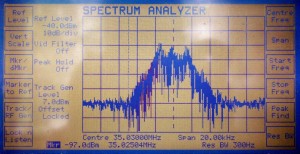When learning to fly my remote controlled helicopter I was also interested in the technical side. In this post I’ll write down what I discovered about the “air interface”.
In most (every?) countries, the use of the electromagnetic spectrum is limited by law. Some frequencies are almost universally reserved for public use (the 2.4GHz band used by e.g. WLANs). Other bands are highly restricted (the band around 120MHz, used for communication with real airplanes). In Belgium, the 35MHz band is reserved exclusively for model aircrafts. Other bands popular around the world are the 40MHz and 72MHz band.
The frequencies
The Belgian 35MHz band runs from 34.995MHz up to 35.335MHz. This spectrum is divided into 33 channels of each 10kHz wide, centered at 35.000MHz + n*10kHz. The ERP is limited to 100mW. [bipt.be]
The signal is modulated using frequency modulation (FM). The signal’s amplitude is digital, so it is actually called frequency shift keying (FSK): only 2 frequencies are used: fc±1.5kHz where fc is the center frequency. [1][2]
Spectrally, it looks like this:

This is the spectrum of my FF9 using PCM modulation and a synthesizer HF-module for the 35MHz band. As you can see, the power leaked to adjacent channels is at least 30dB (i.e. a factor 1000) below the main channel. Note that the left and right side of the spectrum show the noise level.
The signal
The usual problem arises: we have a single channel, but we want to transmit multiple signals. Depending on the transmitter you choose, the number of signals ranges from 2 (cheap RC car) to 9 (advanced heli Tx) or even more. To combine those 9 signals into a single one, some multiplexing is needed.
The two most used signal types are PPM (also incorrectly named FM) and PCM. PPM is the “analogue” variant, while PCM is fully digital. Remember that both types of signals are modulated using Frequency Modulation (FM). This site gives a very nice breakdown on how both PPM and PCM are generated. These papers [1, local mirror][2, local mirror] go more into detail on the Futaba variant of the PCM signal.

Long-term Memory » Blog Archive » Flight log 2008-08-30 says:
[…] The 0h18 Tx time is for the spectral analysis. […]
2008-10-26, 10:25